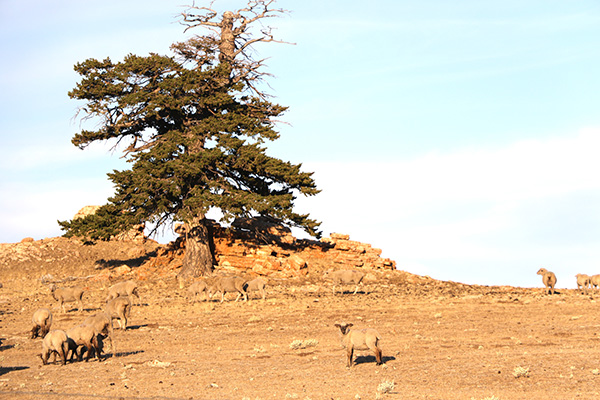Sheep industry update: ASI and ALB continue work to promote American lamb

The Wyoming Wool Growers Association (WWGA) Summer Membership Meeting, held Aug. 10-11 in Lander, hosted informative topics on current issues producers of lamb and wool face, as well as highlighted the opportunities existing for producers and honored individuals who have dedicated time and energy to advancing sheep production in the state.
American Sheep Industry (ASI) Vice President Brad Boner of Glenrock and American Lamb Board (ALB) Vice Chair Peter John Camino of Buffalo were among the speakers slated to provide updates on the status of the American sheep industry.
Positive outlook from ASI
The news of an uptick in the lamb market brings much hope to producers following the rough 2020 production year. Boner shared there were two major positive aspects brought to the lamb industry following the COVID-19 pandemic – experimental cooking and stimulus support.
“The lamb market is on fire, and there were a few positive things brought to the lamb industry by COVID-19,” said Boner. “The demand of lamb increased, especially as people decided they were going to learn how to cook at home again, and lamb was a big benefactor of people not being able to eat out and doing a lot of experimental cooking at home.”
He added, “The other good thing that helped us get through the pandemic, following the lamb crash at the busiest season for the lamb market around Easter, was ASI and partners in state organizations went to work with the U.S. Department of Agriculture and were able to get Coronavirus Food Assistance Program (CFAP) payments.”
Boner noted around $160 million in CFAP payments were distributed to producers working in the sheep industry, and he believes this helped most operators to sustain the rough year.
Opportunities for improvement
While Boner tips his hat to ASI and state foundation partners to help sheep producers through the pandemic, he said there is still room for improvement and challenges to overcome.
“We are still struggling with mandatory price reporting, which is up for renewal at the end of September,” he said. “Currently, the only price reporting we have on slaughter-ready lambs is negotiated, and there is no comprehensive price.”
Boner continued, “Price reporting is a huge issue and centers around confidentiality, so we continue to talk with the Agricultural Marketing Service (AMS) about how we can have great transparency in the lamb market. It’s a struggle, and I don’t know how much progress we are making, but we are continuing to work to make this better.”
Because of the lack of mandatory price reporting, Boner noted, there is no longer Livestock Risk Protection (LRP) for lamb, so the option to alleviate risk is gone due to the lack of lamb insurance. He shared, until the price reporting issue is solved, the risk protection program isn’t coming back.
The pandemic brought both opportunities and challenges for ASI and the sheep industry, out of which comes the Wool Quality Assurance Program, and the identification of improvement in two necessary areas for ASI: Increasing revenue and communication.
Promoting American lamb
Camino shared ALB took a major hit, almost a 25 percent loss, on funding in 2020 due to the loss of fine dining during the COVID-19 pandemic. But, the promotional organization took up a new direction in promoting lamb and has seen success on a decreased budget.
“When COVID-19 hit, ALB found out there were more meals being prepared at home and food was recognized for the entertainment value, increasing kitchen cooking,” Camino said. “People found out they could cook a restaurant-quality meal at home.”
He continued, “This increase, as well as the strong desire for consumers to connect the food on their plates to the farmers and ranchers who produced the food, has picked up the lamb market. The sale of lamb has skyrocketed and the consumer demand for lamb has increased.”
ALB has met the consumer interest in learning how to cook lamb, as well as in learning how lamb is raised, Camino noted. ALB launched social media campaigns and hosted cooking classes to follow the increase of retail support and the amount of lamb sold in grocery stores.
The newest campaign is “Outdoor Cooking Adventures,” geared towards grilling, smoking and cooking lamb over a live fire.
In addition, ALB has partnered with the University of Michigan to evaluate the environmental footprint of the U.S. sheep industry, Camino shared.
“We are in the second year of a three-year study, and we are looking forward to sharing the positive impact of sheep on the environment,” he said. “When this gets done, we will have proof the sheep industry is a nonpolluting industry.”
Boner and Camino’s presidential terms serving both the ASI and ALB will align within the next year, and Boner shared, “We have the unique opportunity in Wyoming to affect some change.”
The pair appreciates input on how to further the results of ASI and ALB.
Look for more on the Wool Quality Assurance Program in a future edition of the Wyoming Livestock Roundup.
Averi Hales is the editor of the Wyoming Livestock Roundup. Send comments on this article to roundup@wylr.net.





